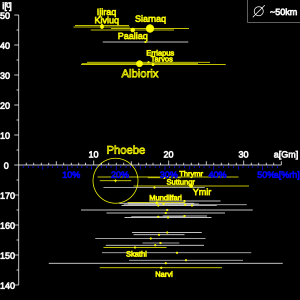Saturn's Gallic group of satellites facts for kids
The Gallic group is a family of small, icy moons that orbit the planet Saturn. These moons are called "irregular" because they don't follow the usual, neat paths around Saturn like the larger moons do. Instead, they have orbits that are a bit tilted and stretched out. All the moons in this group move in the same direction as Saturn spins, which is called "prograde" motion.
The International Astronomical Union (IAU) is the group that names planets, moons, and other space objects. They decided that the moons in the Gallic group should be named after characters from ancient Gallic (Celtic) stories.
Meet the Gallic Moons
Scientists believe that all the moons in the Gallic group might have come from a single, larger moon that broke apart a long time ago. This is because they all have very similar orbits around Saturn. Their paths are between 16 and 19 million kilometers away from Saturn. Their orbits are also tilted by about 35 to 40 degrees compared to Saturn's equator, and they are quite stretched out, not perfectly round.
The picture on the right shows the Gallic group compared to other irregular moons of Saturn. The yellow lines show how stretched out their orbits are, and the height on the chart shows how tilted their orbits are.
The four known moons in the Gallic group are:
Colors and Clues
Scientists have studied these moons and found that they are all a similar light-red color. They also reflect infrared light in a similar way. This supports the idea that they all came from the same original body.
However, recent observations have shown something interesting about Albiorix, which is the largest moon in this group. It actually has two different colors on its surface! One part of Albiorix is the same light-red color as Erriapo and Tarvos. But another part is less red.
This discovery made scientists think a new idea. Instead of all the moons coming from one big moon that just broke apart, maybe Tarvos and Erriapo are actually pieces that broke off from Albiorix itself! This could have happened if a large object crashed into Albiorix, creating a huge crater that exposed less red material underneath.
For such a crash to happen, the object hitting Albiorix would need to be bigger than 1 kilometer (about 0.6 miles) across. It would also have to be moving very fast, almost 5 kilometers per second (about 3 miles per second). This kind of impact could create a crater about 12 kilometers (about 7.5 miles) wide on Albiorix. We know that such big collisions have happened in Saturn's past because we see many very large craters on another moon called Phoebe.
Images for kids
See also
 In Spanish: Grupo Gálico para niños
In Spanish: Grupo Gálico para niños



